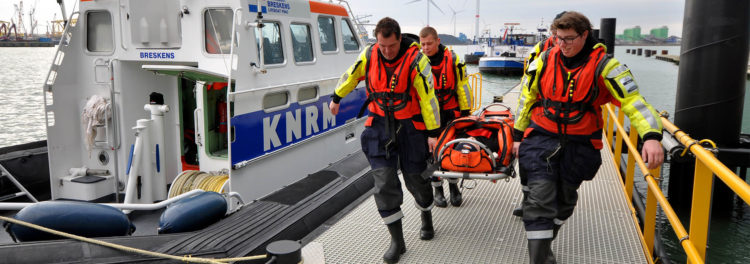KNRM, Lifeguards on the IJsselmeer and the Wadden Sea
The Royal Dutch Lifeboat Association helps and rescues people in distress on the water and at sea in the Netherlands. Volunteer rescuers and lifeboats are on standby 24 hours a day for emergency assistance. Based on good seamanship, the KNRM provides assistance on the water to anyone who is in need. KNRM rescues and helps, free of charge, and has done so since 1824!
But how does it work? Who are these volunteers and do they really save everyone? We are happy to explain it in this article!
Who will come to your rescue if your sailboat threatens to sink on the IJsselmeer?
Wondering who to call if you have problems on the water? Whether in the middle of the IJsselmeer or between the Wadden Islands. Right, the KNRM. On all Wadden Islands but also in the harbours of Harlingen, Enkhuizen, Scheveningen and other important places around the IJsselmeer and along the Dutch coast you will find the boathouses of the KNRM.

As soon as an emergency call is received, the trained volunteers of the KNRM jump into one of the rescue boats and set off. There is, of course, a distinction between non-life-threatening fumbling in a sailing boat or an oil tanker in distress with a risk of explosion. But help, they always come!
What exactly does the KNRM do along the Dutch coast?
The KNRM prevents incidents where possible. They rescue and help people where they need to. From harbour to waterway, from beach to sea. They do this 24/7, 365 days a year and under all circumstances. And you don’t have to pay for it. KNRM is not a government service, but an independent organization with its own financing, which is maintained by donations and gifts.

What exactly does that mean? Below is a list of the main tasks of the Royal Dutch Lifeboat Association! First of all:
Emergency assistance: Search and Rescue (SAR)
International name for rescue of drowning persons at sea. In the Netherlands, the coastguard centre is in Den Helder. The KNRM performs SAR tasks under the operational management of the KWC. The KNRM has committed itself by means of a covenant to be available 24 hours a day at the request of the Coastguard.
Beach surveillance by lifeguards of the KNRM
Speaks for itself, Baywatch in the countryside. There is beach surveillance on busy beaches along the Dutch coast, the IJsselmeer and the Wadden Sea. The volunteer lifeguards of the KNRM are on standby in the high season to guarantee the safety of beach visitors and swimmers.
Radio medical service of the KNRM
The Radio Medical Service is staffed throughout the year by doctors who, in addition to their normal jobs, are on call to assist ships’ crews in need of medical assistance. They give advice and remain on standby until the KNRM is at the scene.
Coastal assistance by the KNRM
The KNRM is of course most active on the water, but they are also essential on land. The rescue stations along the North Sea coast all have a Coastal Rescue Vehicle or truck. A special truck for assistance on the beach, in the dunes and on other difficult terrain.
The emergency rescue trucks support the rescue boats from the mainland during major searches but are also usually used for transporting injured people from the beach.
Safety and prevention at KNRM
The KNRM is a non-profit organization and wants to contribute to awareness of the dangers on the water. So that everyone can safely enjoy a day of swimming or sailing at the coast or on the IJsselmeer.
By paying attention to prevention and making people aware of the dangers, drowning, injury and material damage on and around the water should be prevented. The basic principle of the KNRM prevention programme is therefore: Safe out, safe home!
KNRM does this by regularly organising lectures, showing a film and answering questions at locations such as schools and specially organised meetings. They also provide training to sailors and other water sports enthusiasts in special offshore training centres.

What KNRM means to the traditional sailing fleet
The historic sailing ships of the Dutch sailing fleet also have to deal with the KNRM. Even though a ship complies with all inspections, it may happen that the help of the KNRM is needed. Think, for example, of the rare occasions when a person on board becomes unwell or when there is a technical malfunction that requires assistance. On many ships of the Historic Sailing Fleet you will find donation jars or the skipper is a member of the KNRM and so supports monthly.
How can you support the KNRM
KNRM can use all the help it can get and is happy with every donation. So become a donor or ‘lifesaver on shore’ or make a one-off donation. With your contribution, the KNRM ensures that their rescuers can be properly trained and that the equipment they use continues to meet the high safety requirements.
Not only can you support the KNRM financially, because they can also use your help as a volunteer! If you are interested in becoming a lifeguard or sea rescue worker at the KNRM, you will find more information here.

